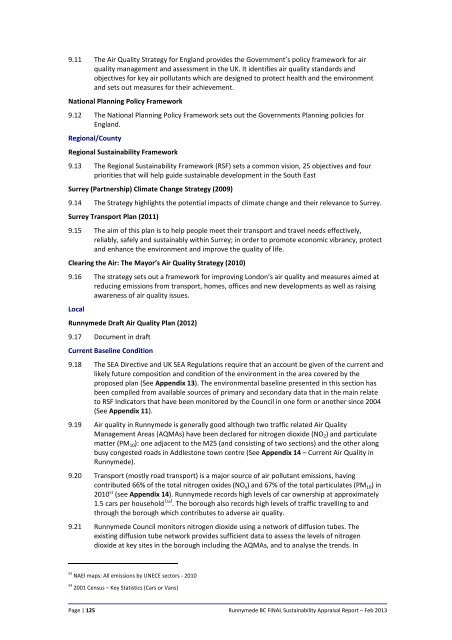DRAFT Sustainability Appraisal Report for the Emerging Local Plan ...
DRAFT Sustainability Appraisal Report for the Emerging Local Plan ...
DRAFT Sustainability Appraisal Report for the Emerging Local Plan ...
Create successful ePaper yourself
Turn your PDF publications into a flip-book with our unique Google optimized e-Paper software.
9.11 The Air Quality Strategy <strong>for</strong> England provides <strong>the</strong> Government’s policy framework <strong>for</strong> air<br />
quality management and assessment in <strong>the</strong> UK. It identifies air quality standards and<br />
objectives <strong>for</strong> key air pollutants which are designed to protect health and <strong>the</strong> environment<br />
and sets out measures <strong>for</strong> <strong>the</strong>ir achievement.<br />
National <strong>Plan</strong>ning Policy Framework<br />
9.12 The National <strong>Plan</strong>ning Policy Framework sets out <strong>the</strong> Governments <strong>Plan</strong>ning policies <strong>for</strong><br />
England.<br />
Regional/County<br />
Regional <strong>Sustainability</strong> Framework<br />
9.13 The Regional <strong>Sustainability</strong> Framework (RSF) sets a common vision, 25 objectives and four<br />
priorities that will help guide sustainable development in <strong>the</strong> South East<br />
Surrey (Partnership) Climate Change Strategy (2009)<br />
9.14 The Strategy highlights <strong>the</strong> potential impacts of climate change and <strong>the</strong>ir relevance to Surrey.<br />
Surrey Transport <strong>Plan</strong> (2011)<br />
9.15 The aim of this plan is to help people meet <strong>the</strong>ir transport and travel needs effectively,<br />
reliably, safely and sustainably within Surrey; in order to promote economic vibrancy, protect<br />
and enhance <strong>the</strong> environment and improve <strong>the</strong> quality of life.<br />
Clearing <strong>the</strong> Air: The Mayor’s Air Quality Strategy (2010)<br />
9.16 The strategy sets out a framework <strong>for</strong> improving London’s air quality and measures aimed at<br />
reducing emissions from transport, homes, offices and new developments as well as raising<br />
awareness of air quality issues.<br />
<strong>Local</strong><br />
Runnymede Draft Air Quality <strong>Plan</strong> (2012)<br />
9.17 Document in draft<br />
Current Baseline Condition<br />
9.18 The SEA Directive and UK SEA Regulations require that an account be given of <strong>the</strong> current and<br />
likely future composition and condition of <strong>the</strong> environment in <strong>the</strong> area covered by <strong>the</strong><br />
proposed plan (See Appendix 13). The environmental baseline presented in this section has<br />
been compiled from available sources of primary and secondary data that in <strong>the</strong> main relate<br />
to RSF Indicators that have been monitored by <strong>the</strong> Council in one <strong>for</strong>m or ano<strong>the</strong>r since 2004<br />
(See Appendix 11).<br />
9.19 Air quality in Runnymede is generally good although two traffic related Air Quality<br />
Management Areas (AQMAs) have been declared <strong>for</strong> nitrogen dioxide (NO 2 ) and particulate<br />
matter (PM 10 ): one adjacent to <strong>the</strong> M25 (and consisting of two sections) and <strong>the</strong> o<strong>the</strong>r along<br />
busy congested roads in Addlestone town centre (See Appendix 14 – Current Air Quality in<br />
Runnymede).<br />
9.20 Transport (mostly road transport) is a major source of air pollutant emissions, having<br />
contributed 66% of <strong>the</strong> total nitrogen oxides (NO x ) and 67% of <strong>the</strong> total particulates (PM 10 ) in<br />
2010 53 (see Appendix 14). Runnymede records high levels of car ownership at approximately<br />
1.5 cars per household ( 54) . The borough also records high levels of traffic travelling to and<br />
through <strong>the</strong> borough which contributes to adverse air quality.<br />
9.21 Runnymede Council monitors nitrogen dioxide using a network of diffusion tubes. The<br />
existing diffusion tube network provides sufficient data to assess <strong>the</strong> levels of nitrogen<br />
dioxide at key sites in <strong>the</strong> borough including <strong>the</strong> AQMAs, and to analyse <strong>the</strong> trends. In<br />
53 NAEI maps: All emissions by UNECE sectors ‐ 2010<br />
54 2001 Census – Key Statistics (Cars or Vans)<br />
Page | 125 Runnymede BC FINAL <strong>Sustainability</strong> <strong>Appraisal</strong> <strong>Report</strong> – Feb 2013

















